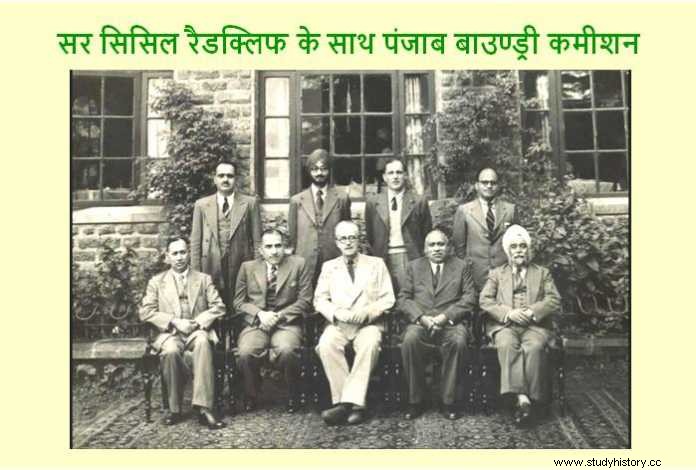
Radcliffe Commission was constituted on 27 June 1947 to determine the boundaries of India and Pakistan. Its president was Sir Cyril Radcliffe, a famous English lawyer. Radcliffe reached Delhi on 8 July 1947. A board of four judges was appointed in each province to assist him. Half of these judges were appointed by the Congress and half by the Muslim League.
The Governor of Punjab, Jenkins, wrote to Mountbatten, demanding that the Radcliffe Commission report must be published before August 15 so that the stampede of the people would end. The Partition Committee of India also made the same appeal to the Viceroy. Wherever Radcliffe went, people surrounded him and tried to influence in their favor. A single stroke of Radcliffe's pen could freeze or dislodge them.
He could do anything to any extent to please that Englishman. Maps, requests, threats and bribes started raining down on Radcliffe. Its report was ready on 9 August 1947, but Mountbatten decided to expose it on 17 August so that there would be no rift in the joy of Independence Day. Due to this there was confusion in Punjab and Bengal.
Neither Indian leaders nor Pakistani leaders were pleased with Radcliffe's work. Both fiercely criticized Radcliffe. Enraged by this, Radcliffe refused to accept the fixed amount of two thousand pounds as remuneration.
While drawing the dividing lines, Cyril Radcliffe paid most attention to what was the religion of the majority of the people. As a result the dividing line drawn was technically correct but practically verifiable. …… The dividing line of Bengal gave an economic curse to both the parts. Pakistan got 85 percent of the world's jute in the area, but there was not a single mill where jute could be consumed.
He had more than a hundred mills in Calcutta. This metropolis came in the part of India but not jute. , The dividing line of Punjab started in the middle of a dense forest situated on the outskirts of Kashmir from where the western stream of river called Ujh enters Punjab. Wherever possible, the dividing line followed the Ravi and the Sutlej rivers. Descending two hundred miles south, he touched the Indian desert. Lahore was given to Pakistan and Amrisar with its Golden Temple came to India's part.
Demand to take Taj Mahal to Pakistan
After the date of partition of India was announced, some Muslims who went to Pakistan demanded that the Taj Mahal should be demolished and taken to Pakistan and rebuilt there, because it was built by a Mughal but this demand could not gain any momentum. .
appointment of new governor generals
The question of the appointment of heads of state in the two new nations that came into existence with the partition of India was no less complicated. The Prime Minister of the Interim Government of India was Jawaharlal Nehru and he was to be appointed as the first Prime Minister of independent India, but a new person was to be appointed in place of the Governor General and Viceroy. In Pakistan, Muhammad Ali Jinnah was to be appointed to one of these two posts and another person was to be appointed to the other post.
Indian leaders accepted Lord Mountbatten to be the Governor General of independent India, but Mountbatten refused this request. On this the generosity of the Indian leaders in England was blown up. Prime Minister Attlee, Leader of the Opposition Winston Churchill and the British Emperor George VI himself sent telegrams to Mountbatten instructing him to accept the proposal of the Indian leaders.
In this way the post of the future Governor General for the future independent India was decided in a very dignified manner. Muhammad Ali Jinnah presented himself for the post of the future Governor General of Pakistan and the post of Prime Minister was fixed for Liaquat Ali. Mountbatten reminded Jinnah that in a democratic system all the powers of governance are vested in the Prime Minister and not the Governor General. Jinnah said, I will be the Governor General in Pakistan and the Prime Minister will have to do what I say.
Narayan Bhaskar Khare, a member of the Viceroy's Council, a member of the Constituent Assembly and the Prime Minister of the state of Alwar, etc., quoted an article published in the Times of India on 14 November 1954 in Part II of his book Meri Desh Sewa. Have given. It refers to a conversation between Louis Fischer and Gandhiji by an American journalist.
Gandhiji said to Louis Fischer- 'When I am the Viceroy of India, I will invite the whites of South Africa to my hut and say that you have crushed my people but I will not follow you. I will treat you kindly. I will not kill blacks like you by lynching. There is a terrible cruelty on your side. If one Gora is killed, all villages are destroyed.'
In this way, Narayan Bhaskar has tried to prove with some more examples that Gandhiji had 'Swadeshi-Viceroy' in mind. wanted to be. When India got independence, this issue did not arise from a single platform. At that time Gandhiji was 78 years old and he had become so weak physically that he could not even walk without taking the help of Manu, Abha and Sushila Ben etc.
